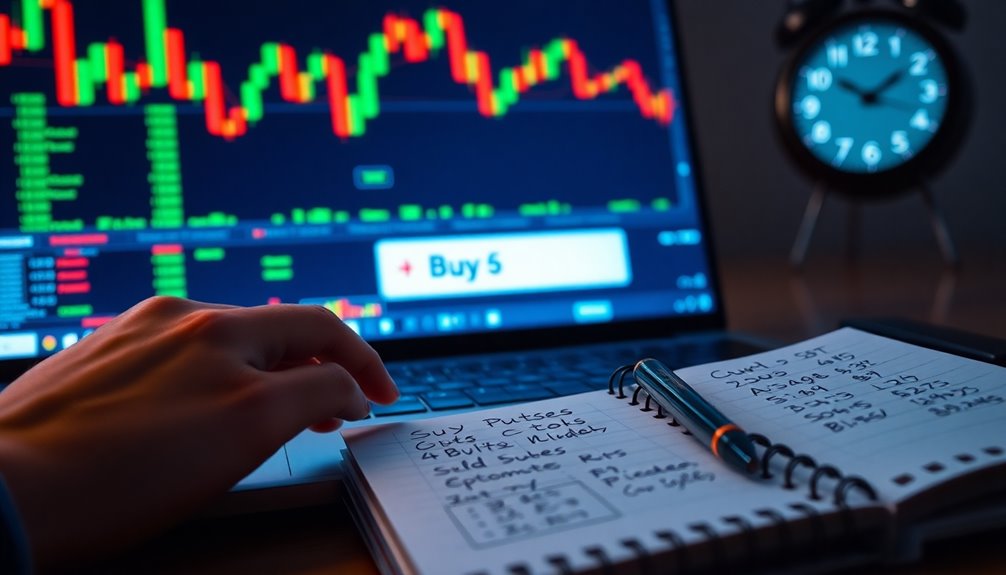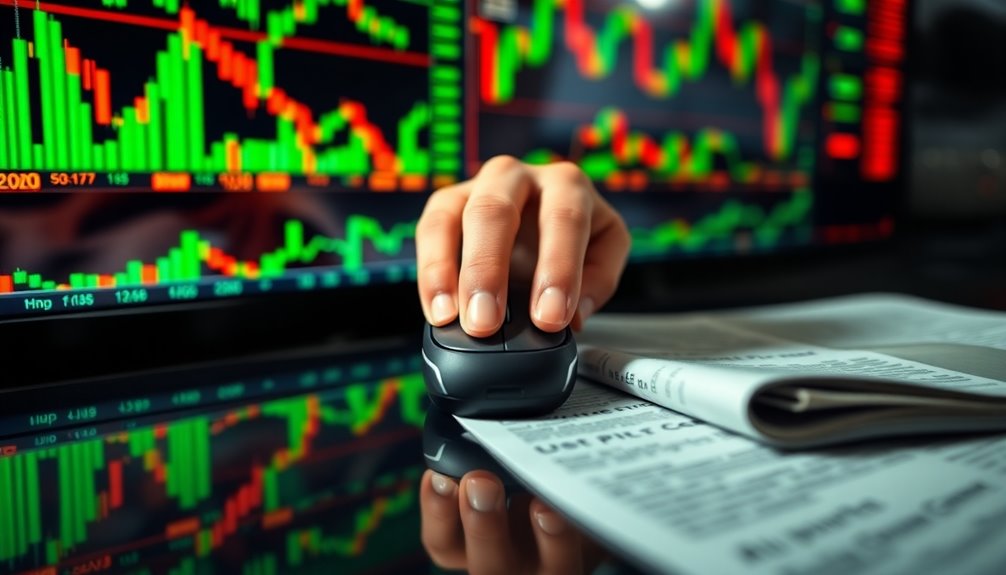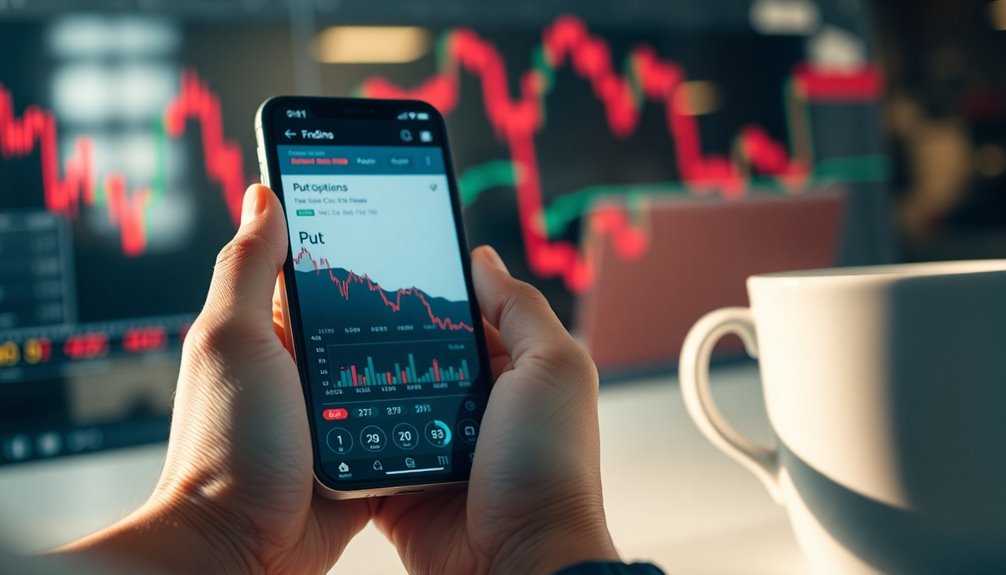Buying puts means you're securing the right to sell an asset, like stocks, at a predetermined price, known as the strike price. This strategy allows you to profit from a decline in the asset's value or to protect yourself against potential losses if you already own the asset. You pay a premium for this right, and your risk is limited to that premium. If the asset's price falls below the strike price before expiration, you can make a profit. Plus, using puts can help you navigate market downturns effectively, and there's much more to explore about how this works.
Key Takeaways
- Buying puts grants the right to sell an asset at a predetermined strike price, reflecting a bearish outlook on the asset's value.
- It involves paying a premium for the option, with limited risk confined to this premium amount.
- Puts can be used for hedging against potential losses in owned assets, providing insurance during market downturns.
- Profit occurs when the asset's price falls below the strike price, leveraging the option for larger position control.
- Market volatility significantly impacts put prices, with higher volatility increasing the value of long put positions.
Puts as Insurance Against Losses

When you own stocks, the potential for loss can be a real concern, especially during market downturns.
A protective put strategy acts like insurance against these declines. By owning a stock and purchasing a put option on it, you secure the right to sell your shares at a predetermined strike price if the market takes a dive. This limits your losses, setting a floor for your stock's value until the option expires.
While you'll pay a premium for this protection, which is your maximum loss if it expires worthless, it allows you to maintain your position in the stock while mitigating downside risk. This strategy is particularly appealing for risk-averse investors who want to protect their investments without selling their shares.
Thus, protective puts help you navigate turbulent market conditions with greater confidence.
Understanding Put Options

Owning puts not only serves as a form of insurance against losses but also opens the door to various strategies for profiting from market declines.
When you buy a put option, you gain the right to sell the underlying stock at a predetermined strike price before the expiration date. This strategy reflects a bearish outlook, allowing you to speculate on price drops or hedge against potential losses in your existing investments. Your risk is limited to the premium you pay, which is a significant advantage over short-selling. As the stock price falls, the value of your put increases. Additionally, understanding market fluctuations can lead to rapid appreciation in put option value.
However, be aware of time decay and volatility, as these factors can impact your option's value.
Mechanism of Put Options

Put options function as contracts that establish an agreement between a buyer and a seller regarding the exchange of an underlying asset.
As a buyer, you gain the right, but not the obligation, to sell the asset at a predetermined strike price before the expiration date. If you choose to exercise the option, the seller must purchase the asset at that strike price. Each contract typically represents 100 shares, and you don't need to own the asset to trade puts. The strike price and expiration date are crucial, as your profit hinges on the asset's price falling below the strike price. Additionally, put options can be traded on various assets including stocks, currencies, commodities, and indices. Keep in mind that while you stand to profit, the seller benefits if the price stays above the strike price.
Pros and Cons of Puts

While buying puts can be an effective strategy for managing risk, it's essential to weigh the pros and cons before diving in.
On the upside, puts offer hedging against asset declines, limiting your risk to the premium paid. They provide leverage, allowing you to control more significant positions without needing to buy the underlying asset outright. Plus, they let you profit from falling stock prices without short selling. Additionally, puts can be used as a form of insurance for stockholders against price declines.
However, consider the costs involved; the premium can eat into your returns. Time decay means the option loses value as expiration nears, and if the stock doesn't drop below the strike price, you'll lose the premium.
Understanding these factors can help you make informed decisions about buying puts.
Puts vs. Calls Analysis

Investors often face a critical choice between puts and calls when navigating the options market.
If you expect a decline in the underlying asset's price, buying puts could be your strategy. Puts give you the right to sell at a predetermined price, providing a hedge against losses or a way to profit in bearish conditions. Understanding market expectations is essential when deciding between puts and calls, as it can significantly influence your investment outcomes.
Conversely, if you anticipate price increases, call options are your go-to, granting the right to buy at a set price.
The choice hinges on your market outlook—puts thrive in falling markets while calls excel in rising ones. Understanding these dynamics can help you align your strategies with market trends, ultimately enhancing your investment decisions.
Market Volatility Impact

Understanding the impact of market volatility is crucial when trading long put options, as it can significantly influence your potential profits.
When volatility rises, your long put positions benefit, often boosting option prices. At market tops, implied volatility is low, making puts cheaper, but a subsequent rise can enhance your profits despite time decay. Additionally, this relationship between price declines and implied volatility increases reinforces the potential gains for put holders.
Conversely, falling volatility can hurt your positions. After major events, volatility often drops, leading to a "volatility crush" that can significantly reduce put premiums.
As the underlying asset's price decreases, implied volatility usually increases, working in your favor.
Emerging Market Put Activity

How do emerging markets shape put activity? In these markets, high price volatility and lower liquidity create unique opportunities for put buying. When prices fluctuate dramatically, you can use puts to hedge against potential losses or speculate on downturns. Additionally, buying puts can serve as a form of insurance against portfolio losses in these unpredictable environments.
The operational complexities and risks, like political instability and credit issues, further drive you to consider protective strategies. As multinational banks and institutional investors dive into emerging markets, the demand for put options rises, enhancing liquidity in these instruments.
This activity can be a response to unexpected events, such as regulatory changes or economic disruptions. By understanding these dynamics, you can make informed decisions about your put purchases in emerging markets.
Timing Your Purchases Wisely

Timing your purchases wisely can significantly impact your success when buying put options. Start by choosing the right strike price; it should be set below the current market price. Remember, a further out-of-the-money strike price is less expensive but offers a lower chance of success.
Next, select an appropriate expiration date—longer dates cost more but give you more flexibility. Evaluate the options chain for those with a high delta; options with a delta of -0.5 or lower may be preferable. Additionally, be aware that put options derive value from the underlying securities, making them complex and potentially risky.
Finally, stay alert to market conditions. You might need to adjust your position by rolling out options to manage risk effectively. Continuous monitoring is key to determining the right time to exercise or let your options expire.
Frequently Asked Questions
Can I Buy Puts on Stocks I Don't Own?
Yes, you can buy puts on stocks you don't own. This strategy, called a "naked put," lets you speculate on a stock's decline without holding the shares.
It allows you to benefit from bearish movements at a lower cost compared to actually buying the stock. Your maximum loss is limited to the premium you paid for the put.
Just remember to choose your strike price and expiration wisely to enhance your chances of success.
How Do Taxes Affect Profits From Buying Puts?
Isn't it funny how avoiding taxes can end up costing you more?
When you buy puts, you won't owe taxes until you sell the underlying stock. If you hold it for over a year, you might get a nice long-term capital gains rate.
But if you sell sooner, those gains are short-term and taxed at a higher rate.
What Is the Minimum Investment for Buying Puts?
To determine the minimum investment for buying puts, you need to consider the premium cost of the option.
Each put contract typically represents 100 shares, so if the premium is $5 per share, you're looking at a $500 investment for one contract.
Remember, this doesn't include any brokerage fees.
Additionally, choosing the right strike price and expiration date can significantly affect the overall cost and investment strategy.
Are There Any Fees Associated With Buying Put Options?
Yes, there are fees associated with buying put options.
You'll pay a premium for the option itself, which is calculated per share. Additionally, regulatory fees like the Trading Activity Fee and Options Regulatory Fee apply to your trades.
Your brokerage might charge fees too, depending on their policies.
Can I Sell Put Options I've Purchased?
Did you know that about 30% of options traders sell put options to generate income?
Yes, you can sell put options you've purchased before they expire. By doing this, you can capitalize on any time or intrinsic value they may still hold.
Simply place a sell order through your brokerage platform. This strategy allows you to potentially realize profits instead of exercising the option or letting it expire worthless.
Conclusion
In summary, purchasing puts can be a powerful protective strategy. By understanding the ins and outs of put options, you can safeguard your investments against sudden market shifts. Weighing the pros and cons helps you make informed choices, while timing your trades can turn uncertainty into opportunity. So, whether you're navigating a tumultuous terrain or exploring emerging markets, remember that puts provide a potential parachute, cushioning your portfolio from perilous plummets.









